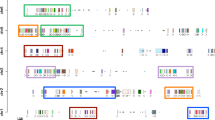Abstract
We find great value in the genomes from the nonmodel organisms papaya and grape. These genomes help us understand the chromosomal history of the super-order rosids. Essential to this process are new, online genomics tools that allow researchers to easily perform their own experiments, such as identifying and evaluating syntenic regions and estimating the degree of post-tetraploidy gene fractionation (diploidization); this process is exemplified here using the online comparative genomics toolset CoGe. Using case studies, we show that two of the three genomes within the rosid paleohexaploid are more fractionated with respect to one another than to a third genome. This indicates a shared history derived from a [tetraploid]-then-[wide cross to generate a triploid]-then-[whole genome duplication to generate the hexaploid,] or similar scenario involving unreduced gametes. Two alternative hypotheses are presented that differ in terms of the mechanism and timing of fractionation.







Similar content being viewed by others
References
Altschul SF, Gish W, Miller W, Myers EW, Lipman DJ (1990) Basic local alignment search tool. J Mol Biol 215:403–410
Ashburner M, Ball CA, Blake JA, Botstein D, Butler H, Cherry JM, Davis AP, Dolinski K, Dwight SS, Eppig JT, Harris MA, Hill DP, Issel-Tarver L, Kasarskis A, Lewis S, Matese JC, Richardson JE, Ringwald M, Rubin GM, Sherlock G (2000) Gene ontology: tool for the unification of biology. The Gene Ontology Consortium. Nat Genet 25:25–29
Bergsten J (2005) A review of long-branch attraction. Cladistics 21:163–193
Bowers JE, Chapman BA, Rong J, Paterson AH (2003) Unravelling angiosperm genome evolution by phylogenetic analysis of chromosomal duplication events. Nature 422:433–438
Brudno M, Do CB, Cooper GM, Kim MF, Davydov E, Green ED, Sidow A, Batzoglou S (2003a) LAGAN and Multi-LAGAN: efficient tools for large-scale multiple alignment of genomic DNA. Genome Res 13:721–731
Brudno M, Malde S, Poliakov A, Do CB, Couronne O, Dubchak I, Batzoglou S (2003b) Glocal alignment: finding rearrangements during alignment. Bioinformatics 1(19 Suppl):I54–I62
Brudno M, Steinkamp R, Morgenstern B (2004) The CHAOS/DIALIGN WWW server for multiple alignment of genomic sequences. Nucleic Acids Res 32:W41–W44
Cannon SB et al (2006) Legume genome evolution viewed through the Medicago truncatula and Lotus japonicus genomes. Proc Natl Acad Sci U S A 103:14959–14964
Felsenstein J (1978) Cases in which parsimony or compatibility methods will be positively misleading. Syst Zool 27:401–410
Haas BJ, Delcher AL, Wortman JR, Salzberg SL (2004) DAGchainer: a tool for mining segmental genome duplications and synteny. Bioinformatics 20:3643–3646
Hass BJ, Delcher AL, Wortman JR, Saltzberg SL (2004) DAGChainer: a tool for mining segmental genome duplications and synteny. Bioinformatics 20:3643–3646
Jaillon O et al (2007) The grapevine genome sequence suggests ancestral hexaploidization in major angiosperm phyla. Nature 449:463–467
Lespinet O, Wolf YI, Koonin EV, Aravind L (2002) The role of lineage-specific gene family expansion in the evolution of eukaryotes. Genome Res 12:1048–1059
Lockton S, Gaut BS (2005) Plant conserved non-coding sequences and paralogue evolution. Trends Genet 21:60–65
Lyons E, Freeling M (2008) How to usefully compare homologous plant genes and chromosomes as DNA sequence. Plant J 53:661–673
Ming R et al (2008) The draft genome of the transgenic tropical fruit tree papaya (Carica papaya Linnaeus). Nature 452:991–996
Nei M, Rogozin I, Piontkivska H (2000) Purifying selection and birth-and-death evolution in the ubiquitin gene family. Proic Natl Acad Sci USA 97:10866–10871
Ramsey J, Schemske DW (1998) Pathways, mechanisms, and rates of polyploid formation in flowering plants. Ann Rev Ecolog Syst 29:467–501
Rhee SY et al (2003) The Arabidopsis Information Resource (TAIR): a model organism database providing a centralized, curated gateway to Arabidopsis biology, research materials and community. Nucleic Acids Res 31:224–228
Schwartz S, Kent WJ, Smit A, Zhang Z, Baertsch R, Hardison RC, Haussler D, Miller W (2003) Human-mouse alignments with BLASTZ. Genome Res 13:103–107
Tang H, Bowers JE, Wang X, Ming R, Alam M, Paterson AH (2008) Synteny and collinearity in plant genomes. Science 320:486–488
Thomas BC, Pedersen B, Freeling M (2006) Following tetraploidy in an Arabidopsis ancestor, genes were removed preferentially from one homeolog leaving clusters enriched in dose-sensitive genes. Genome Res 16:934–946
Thomma BP, Cammue BP, Thevissen K (2002) Plant defensins. Planta 216:193–202
Tuskan GA et al (2006) The genome of black cottonwood, Populus trichocarpa (Torr. & Gray). Science 313:1596–1604
Valesco R, Zharkikh A, Troggio M, Cartwright DA, Cestaro A et al (2007) A high quality draft consensus sequence of the genome of a heterozygous grapevine variety. PLoS One 2:e1326
Acknowledgement
Funded by US National Science Foundation grant DBI0337083 to MF.
Author information
Authors and Affiliations
Corresponding author
Rights and permissions
About this article
Cite this article
Lyons, E., Pedersen, B., Kane, J. et al. The Value of Nonmodel Genomes and an Example Using SynMap Within CoGe to Dissect the Hexaploidy that Predates the Rosids. Tropical Plant Biol. 1, 181–190 (2008). https://doi.org/10.1007/s12042-008-9017-y
Received:
Accepted:
Published:
Issue Date:
DOI: https://doi.org/10.1007/s12042-008-9017-y




